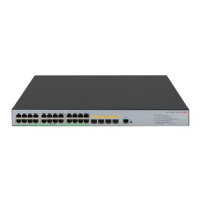403
The C-RP timers need to be configured on C-RP routers.
To configure C-RP timers globally:
Ste
Command Remarks
1. Enter system view.
system-view N/A
2. Enter IPv6 PIM view.
pim ipv6 N/A
3. Configure the C-RP-Adv
interval.
c-rp advertisement-interval interval
Optional.
60 seconds by default.
4. Configure C-RP timeout time.
c-rp holdtime interval
Optional.
150 seconds by default.
For more information about the configuration of other timers in IPv6 PIM-SM, see "Configuring IPv6 PIM
common timers."
Configuring a BSR
An IPv6 BIDIR-PIM domain can have only one BSR, but must have at least one C-BSR. Any router can be
configured as a C-BSR. Elected from C-BSRs, the BSR collects and advertises RP information in the IPv6
BIDIR-PIM domain.
Configuring a C-BSR
C-BSRs must be configured on routers on the backbone network. When you configure a router as a C-BSR,
be sure to specify an IPv6 PIM-SM-enabled interface on the router. The BSR election process is as follows:
• Initially, every C-BSR assumes itself to be the BSR of the IPv6 BIDIR-PIM domain, and uses its
interface IPv6 address as the BSR address to send bootstrap messages.
• When a C-BSR receives the bootstrap message of another C-BSR, it first compares its own priority
with the other C-BSR's priority carried in message. The C-BSR with a higher priority wins. If a tie
exists in the priority, the C-BSR with a higher IPv6 address wins. The loser uses the winner's BSR
address to replace its own BSR address and no longer assumes itself to be the BSR, and the winner
retains its own BSR address and continues assuming itself to be the BSR.
Configuring a legal range of BSR addresses enables filtering of bootstrap messages based on the
address range, thus to prevent a maliciously configured host from masquerading as a BSR. The same
configuration must be made on all routers in the IPv6 BIDIR-PIM domain. The following are typical BSR
spoofing cases and the corresponding preventive measures:
• Some maliciously configured hosts can forge bootstrap messages to fool routers and change RP
mappings. Such attacks often occur on border routers. Because a BSR is inside the network whereas
hosts are outside the network, you can protect a BSR against attacks from external hosts by enabling
the border routers to perform neighbor checks and RPF checks on bootstrap messages and discard
unwanted messages.
• When a router in the network is controlled by an attacker or when an illegal router is present in the
network, the attacker can configure this router as a C-BSR and make it win BSR election to control

